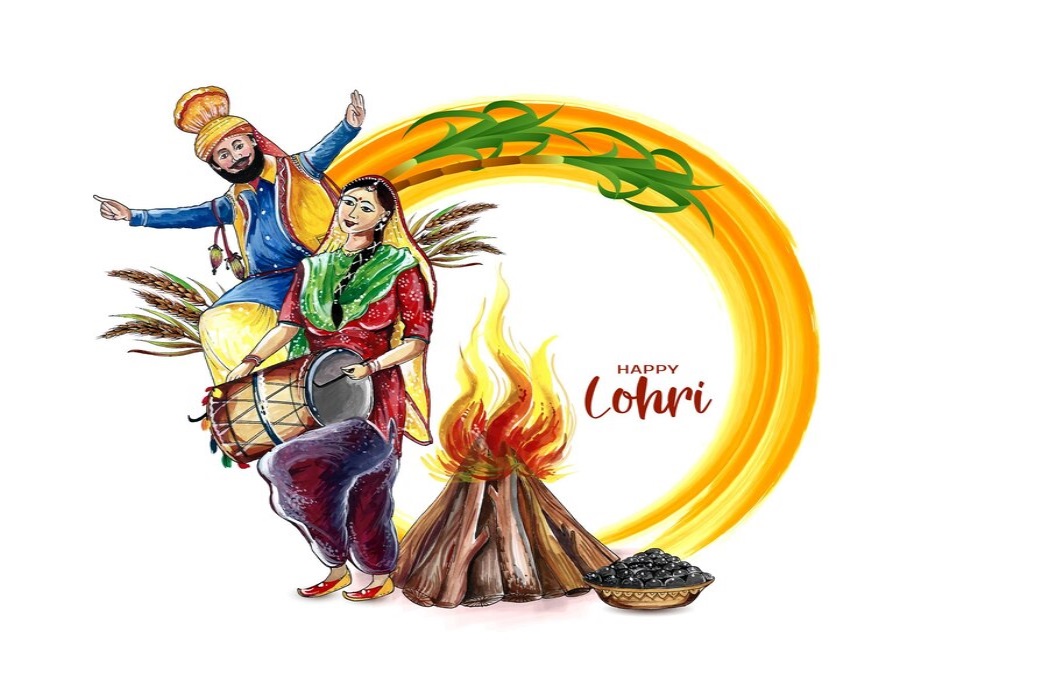Lohri: A Festival of Vibrancy, Bonfires, and Harvest Celebrations
Introduction:
Lohri, a vibrant and exuberant festival, holds a special place in the hearts of people in North India, especially in the states of Punjab, Haryana, and Himachal Pradesh. Celebrated with great fervor on the 13th of January every year, Lohri marks the culmination of winter and the onset of longer days. This essay delves into the rich cultural tapestry of Lohri, exploring its origins, traditions, and the spirit of joy that defines this auspicious festival.
Origins and Significance of Lohri Festival:
The origins of Lohri can be traced back to ancient folklore and agricultural practices. It is believed that Lohri has its roots in the harvest festivals celebrated in the region. The festival signifies the end of the winter solstice and the beginning of longer days, symbolizing the gradual return of warmth and abundance. The word “Lohri” is derived from “Loi,” the name of the traditional bonfire that is a central element of the celebrations.
Traditionally, Lohri was celebrated as a winter solstice festival, with the lighting of bonfires to mark the end of the coldest days and the anticipation of a bountiful harvest. Over time, Lohri has evolved into a cultural extravaganza, combining ancient rituals with lively festivities.
Celebrations and Rituals of Lohri Festival:
Lohri is celebrated with immense enthusiasm, bringing communities together in a spirit of camaraderie. The festivities commence with the gathering of people around a bonfire, which is lit in the evening. This communal bonfire, known as the “Lohri diya,” symbolizes the energy of the sun and is a gesture of gratitude for the bountiful harvest.
People sing traditional Lohri songs and perform the iconic Bhangra and Gidda dances around the bonfire. The rhythmic beats of the dhol, the traditional drum, reverberate through the air, creating an atmosphere of joy and exuberance. The dance and music are not merely performances but expressions of the cultural heritage and collective spirit of the community.
Another integral aspect of Lohri celebrations is the offering of prayers and offerings to the deities. People express their gratitude for the harvest, seeking blessings for prosperity and abundance in the coming year. The traditional “prasad” of sesame seeds, jaggery, and popcorn is distributed, symbolizing the essentials of a good harvest.
Customs and Traditions:
Lohri is also associated with various customs and traditions that add depth to the festivities. One such tradition is the lighting of lamps and candles, symbolizing the triumph of light over darkness. Families adorn their homes with colorful decorations, and the aroma of traditional sweets and delicacies fills the air.
The exchange of gifts and greetings is another cherished tradition during Lohri. Friends and family come together to share the joy of the festival, exchanging sweets, dry fruits, and traditional Lohri treats. This gesture reinforces the sense of community and strengthens social bonds.
Feasting is an integral part of Lohri celebrations. Families and communities come together to savor traditional delicacies like sarson da saag and makki di roti, sesame and jaggery sweets, and the quintessential popcorn and rewari. The feast is not just a culinary indulgence but a communal experience that symbolizes abundance and sharing.
Regional Variations:
While Lohri is predominantly celebrated in Punjab, Haryana, and Himachal Pradesh, variations of the festival are observed in different regions of North India. In some areas, it is known as Pongal in Tamil Nadu, Bhogi in Andhra Pradesh, and Uttarayan in Gujarat. Each region adds its unique cultural touch to the celebrations, creating a tapestry of diverse festivities across the country.
Social Significance:
Beyond its cultural and agricultural roots, Lohri holds social significance as well. The festival provides an opportunity for communities to come together, transcending barriers of caste, creed, and economic status. It fosters a sense of unity and shared joy, reinforcing the cultural fabric that binds people in the region.
Lohri also marks an essential social occasion for newlyweds and newborns. Newly married couples are often the focus of attention, and families celebrate their first Lohri with special enthusiasm. For newborns, Lohri is considered a propitious occasion, and families often organize special rituals to seek blessings for the infant’s well-being.
Environmental Significance:
The bonfires lit during Lohri serve not only as a cultural symbol but also have environmental significance. The burning of agricultural residues, such as sugarcane leaves and husks, in the bonfire helps in clearing fields for the upcoming sowing season. Additionally, the fire is believed to have purifying qualities, cleansing the air and symbolizing the renewal of life.
Contemporary Relevance:
In contemporary times, Lohri has retained its cultural charm while adapting to modern lifestyles. Urban celebrations often involve community events, cultural programs, and even Lohri bonfire gatherings in residential neighborhoods. The festival has transcended regional boundaries, becoming a celebrated occasion for people of diverse backgrounds across the country.
Lohri has also found resonance in the global diaspora, with Indian communities around the world coming together to celebrate this festival of warmth and abundance. The spirit of Lohri serves as a cultural bridge, connecting people to their roots and fostering a sense of shared heritage.
Conclusion:
In conclusion, Lohri is more than just a festival; it is a celebration of life, abundance, and cultural richness. It brings communities together, bridging the gap between tradition and modernity. The bonfire that lights up the Lohri night is not just a physical flame; it is a metaphor for the enduring spirit of the people who gather around it, sharing the warmth of togetherness and the promise of a brighter, more abundant future.
As we celebrate Lohri, let us embrace the traditions, customs, and the festive spirit that define this vibrant festival. May the bonfire of Lohri illuminate our hearts with joy, prosperity, and the enduring bonds of community.
Happy Lohri!

